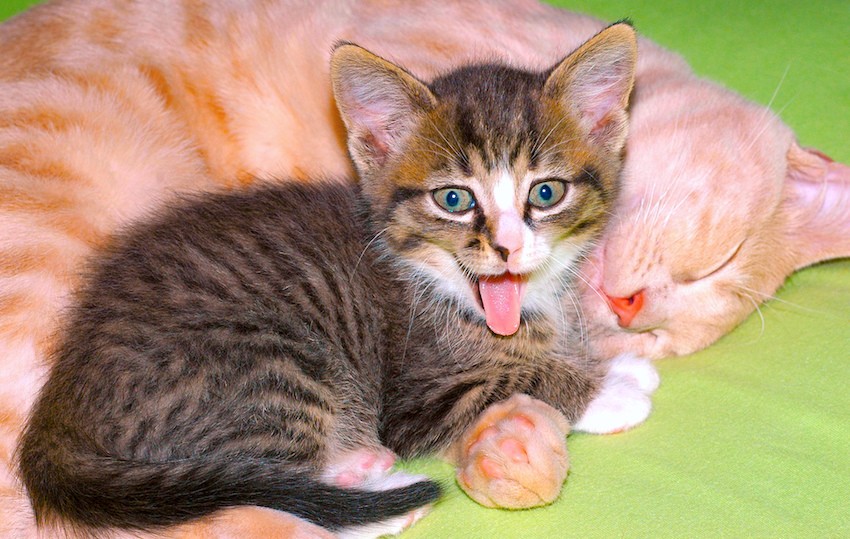
Emrys and Lady, my Abyssinians, stand together on the bureau.
Back to back, they look like bookends. But their tails are entwined in such a way that they almost seem to form a heart.
The entwining — and not the vague heart shape — is their way of showing that they’re a bonded pair.
Cats communicate with each other “through vocalizations, physical contact, visual cues and chemical cues,” according to Dr. Wallani Sung, DVM.
He adds: “When communicating, cats exhibit subtle signaling compared to dogs, due to their smaller features and quicker movements.” If you blink, Dr. Sung says, you may miss a “crucial” bit of communicating between your cats.
Humans are so focused on speech, we sometimes don’t pick up on a cat’s subtler expressions. In this article, we’ll discuss some of the ways cats communicate with each other.
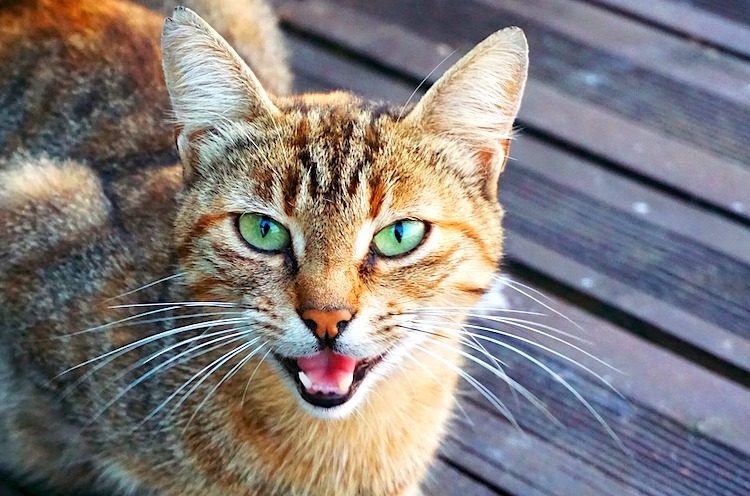
How Cats Communicate With Each Other
There are 3 primary ways that cats communicate with each other (and with you):
- Vocalization
- Body language
- Scent
1. Vocalization
Your cat uses vocalization to tell other cats (or you) what your cat needs.
Different pitches, as well as the intensity and volume of the meowing, reflect the cat’s different emotional and physical requirements.
Loud meowing indicates anxiety and fear, while less intense meowing is their way of showing confidence and contentment.
Sounds can include:
- Murmurs (purring)
- Vowel sounds (meowing)
- High-intensity growls and howls
Yes, “cats may use a meow or trill sound in greeting each other,” says Dr. Sung, “but research has shown that cats tend to meow more when interacting with humans and do not use it often when they are interacting with each other.”
So the meowing is more of a “care-soliciting vocalization” reserved mostly for humans, he says.
But it’s not as clear-cut as that.
You see, domestic cats are “more vocal than feral cats, as feral cats are nearly silent most of the time,” according to cat-care website Green Gato. “The only sounds you’ll hear coming from feral cats are hisses and perhaps a purr.”
This makes perfect sense. A feral cat’s life is infinitely more perilous: They are both predator and prey, and silence and stealth are key for survival in their world.
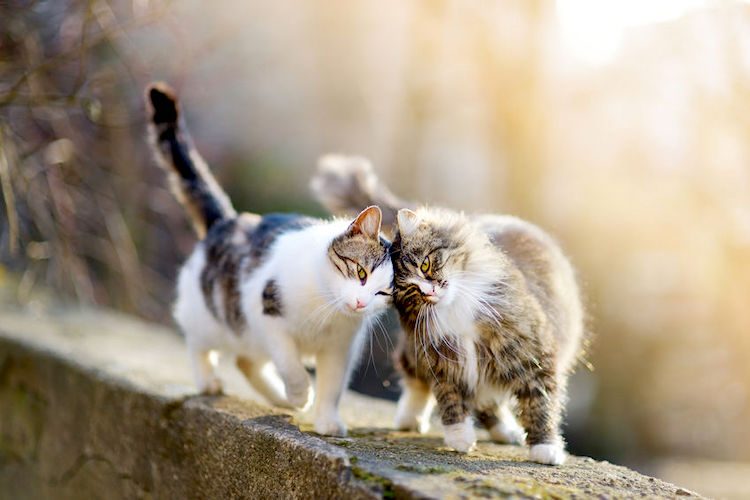
2. Body Language
Watch your cats’ body language when they’re interacting with one another. It’s not the only form of inter-feline communication, but it’s an important one.
Was YOUR Pet Food Recalled?
Check Now: Blue Buffalo • Science Diet • Purina • Wellness • 4health • Canine Carry Outs • Friskies • Taste of the Wild • See 200+ more brands…

Cats have many ways of conveying love and liking:
- They greet each other by touching noses or rubbing against each other.
- Licking the top of another’s cat head is one way of doing this.
Magwitch, my snowshoe Siamese, is very attached to Phoebe, his foster mom. He often licks the top of her head as an affectionate greeting as he passes her in the hallway or on the stairway.
The same gesture can be used to comfort a cat who’s unhappy.
Years ago, Circe, our blue Aby, was grieving over a dying cat friend. Phoenix, another Aby, came over to her and began doing the head-grooming thing. It did seem to soothe Circe.
The reason for that? The gesture is a throwback to kittenhood, when the mother cat spends much of her time and energy grooming her babies. In turn, the kittens feel blissfully secure as she bathes them.
Something of this memory lingers in their furry feline psyches, and they use it to convey love and tenderness as adults.
Cat buddies also nap together (at this moment, there are 3 cats doing some serious synchronized sleeping on my spare-room bed), groom each other and play together.
Two cats meeting each other often go through a stylized set of rituals:
- The more established cat will hiss at the newcomer.
- Sometimes the new cat will hiss back.
It’s essentially a warning on the resident cat’s part. It may not lead to anything, depending on the personalities of the cats involved.
The hissing may be accompanied by a growl if the other cat doesn’t back off right away. But unless there’ some serious tail-lashing and shrieking, there’s usually little to worry about.
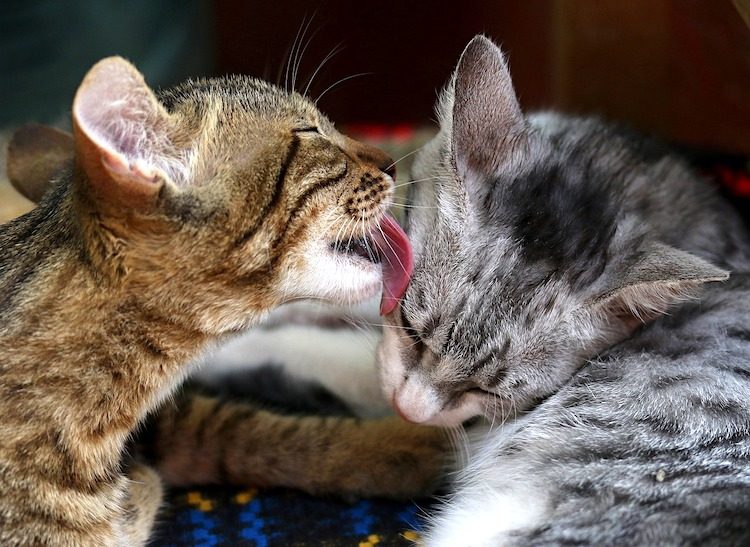
Sometimes a cat or kitten will roll over, exposing part of their belly to another cat. We tend to view this as a sort of “come hither” or an invitation to play, which it can be.
As writer Leslie Carver points out on The Nest, “This behavior is often seen in kittens and young cats, who will ‘play-fight’ with their littermates or roommates this way.”
But there other meanings as well. It may show trust between 2 cats, a willingness to be vulnerable. Or it could signify something very different.
“In the wild, feral cats expose their stomachs as a defensive posture,” explains Dr. Natalie Waggener, DVM.
The cats “fight off predators by rolling onto their backs,” she says. “For example, if a cat gets into a fight, it will turn over to give itself access to all its available weapons (teeth and claws) to fend off an attacker. A supine position allows a cornered cat to fight and protect its vital organs located in the underbelly.”
- Eyes wide open and dilated, ears lying flat, and tail lashing tell you that all is not well between your cats, that there’s a fight about to happen.
- On the flip side, ears upright and eyes closed or slitted mean the cats have worked out their issues and are at ease with one another.
Cats are, Green Gato says, “very into being alert and cognizant of their surroundings.” So if your cat “closes their eyes around another cat, it means they trust them enough not to have all eyes at full attention.”

3. Scent (This is the #1 Way Cats Communicate With Each Other)
OK, so scent is a big deal in cat interactions.
Cats rub their faces (which have pheromone-releasing glands in them) together, same as they would against their people. “Cats can be very social,” Dr. Sung says. “They show affection by rubbing their heads against each other and along the sides of their bodies.”
When they do this, “they deposit pheromones and oils from the scent glands located on their foreheads, cheeks and chins. They also exchange scents when their bodies and tails rub against each other,” he adds.
Rex Petzler, a cat behavior writer at PetPlus, agrees. “The primary way in which cats communicate with each other is through scent markings,” he says. “You may often find a cat rubbing her head against another cat’s cheek. This action is a way of saying the two are comfortable in each other’s company.”
It’s another way of showing friendship. But scent plays a role even when the cats in question aren’t particularly bonded. Yep, we’re talking about butt-sniffing and spraying.
And while cats don’t seem to get into butt-sniffing as thoroughly as dogs do, they use it as a sort of greeting.
“After smelling each other’s face and neck, they start smelling each other’s butt — but only if they feel comfortable doing so,” explains blogger Dianda van Gunst. “Smelling the butt means something like, ‘How are you doing?’ It is a friendly and polite ‘handshake’ between two cats who know each other.”
And spraying? That’s a purely territorial thing.
You could argue that not covering up solid waste in the litter box is a sort of one-upmanship. After all, the cat who refuses to cover up is telling the rest of the gang that they are the top cat — but it goes a little further than that.
“When cats first encounter the litter boxes of other cats,” Thomas McNamee writes in The Inner Lives of Cats, “they pay close attention to whatever information is encoded there…. We know that it’s way more than territorial marking and sexual signals, but a translation of the cat’s vocabulary of scent into anything meaningful to the human mind remains an unexplored opportunity.”
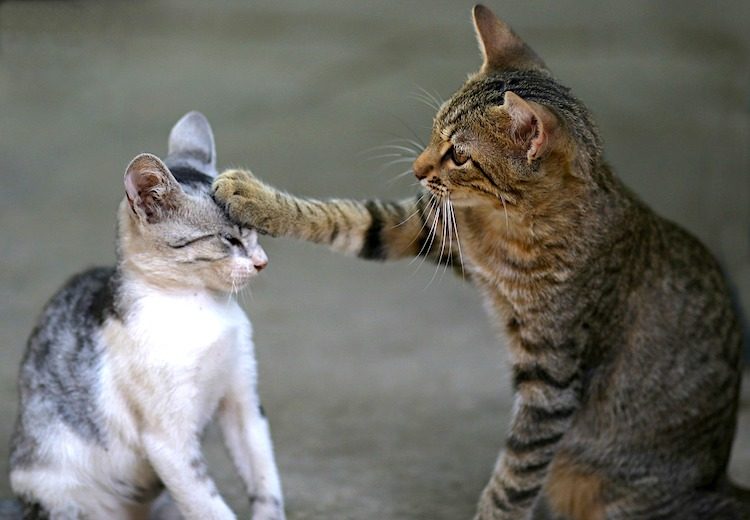
Bottom Line: It’s Complicated
Figuring out what cats are saying to each other is a lot like watching a silent film — but without the printed text between scenes. You spend a lot of time trying to figure out what they’re saying.
- An older female cat inspects a younger one’s kittens. Then she goes over to “have a word” with the mother and leaves soon afterward. Is she leaving to avoid getting stuck with kitten-sitting? Or has she just given the young mother unsolicited — and unwanted — advice?
- Or, in another scenario, 2 cats have always hated each other and bickered for position. One day, one cat curls up very close to the other. There’s no hissing or spitting. Are they friends now or “frenemies”?
The possibilities in both scenarios are intriguing.
“Cat communication with other cats is what we need to understand, but far from all,” McNamee observes. “A lot of cat-to-cat information exchange is body language, and people watching cats over time have come to understand it pretty well. Cats use most of the same postures, expressions and gestures to express the same things to us.”
It’s easy to be accused of anthropomorphizing, of playing Dr. Doolittle. But the more we study how cats interact with one another, the more we come to understand them and the ways in which they are like us yet not like us.
Check out this fascinating video from National Geographic, which looks at the various ways cats communicate with each other:

References
- Sung, Wallani, DVM. “Cat Language 101: How Do Cats Talk to Each Other?” PetMD. Oct. 11, 2018. https://www.petmd.com/news/view/cat-language-101-how-do-cats-talk-each-other-37620.
- “How Do Cats Communicate With Each Other?” Green Gato. Sept. 2, 2015. https://www.greengato.com/how-do-cats-communicate-with-each-other/.
- Carver, Leslie. “What Is the Meaning of a Cat Exposing Their Tummy?” The Nest. https://pets.thenest.com/meaning-cat-exposing-tummy-9836.html.
- Waggener, Natalie, DVM. “What Does It Mean When My Cat Shows Its Belly?” South Boston Animal Hospital. Jan. 3, 2018. https://www.southbostonanimalhospital.com/blog/what-does-it-mean-when-my-cat-shows-its-belly.
- Petzler, Rex. “How Do Cats Communicate With Each Other?” PetPlus. Sept. 1, 2017. https://blog.petplus.com/pet-plus-pups/how-do-cats-communicate-with-each-other/.
- Van Gunst, Dianda. “Why Do Cats Smell Butts?” Kattige Katten. Feb. 4, 2015.
- McNamee, Thomas. The Inner Life of Cats: The Sciences and Secrets of Our Mysterious Feline Companions. Hachette Book Group. 2017.


